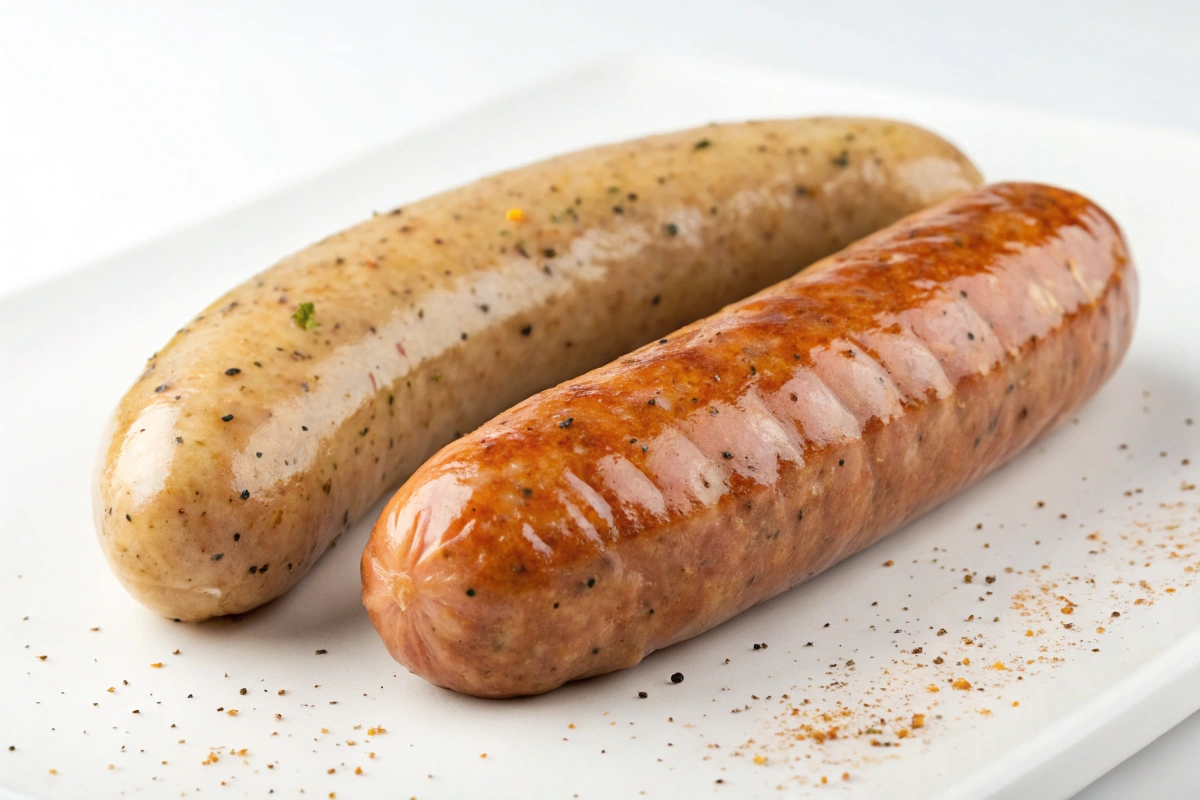This article clarifies the difference between a frank and a brat. Discover their unique traits, from ingredients to flavor profiles, to make informed culinary choices.
Exploring the Difference Between a Frank and a Brat: The Basics
Many people enjoy grilled sausages, however, they sometimes find it confusing to distinguish between different types. Therefore, understanding the variations between a frank and a brat is key to making the right selection. Chiefly, this guide aims to clarify the difference between a frank and a brat. Furthermore, we’ll explore their characteristics, ingredients, and ideal cooking methods. Indeed, you will also learn about their traditional pairings and regional variations. Additionally, by the end of this article, you’ll be equipped with the knowledge to confidently differentiate between the two. Ultimately, this deeper understanding will enhance your enjoyment of both types of sausage.
What defines a Sausage? A broader Look
Before delving directly into the differences between a frank and a brat, it’s important to briefly consider what defines a sausage. Basically, a sausage is a food product made of ground meat, typically encased in a skin. Moreover, sausages can be made from various meats like pork, beef, or poultry, and may include different spices, herbs, and other additives. Specifically, the methods of preparation and preservation vary greatly, leading to the vast array of sausage varieties available worldwide. Therefore, understanding the basic concept of sausage helps in distinguishing types such as franks and brats. Consequently, you can consider them as just two examples of this diverse culinary creation.
Exploring the Difference Between a Frank and a Brat: The Basics
Basically, the terms “frank” and “brat” often lead to misunderstandings, especially since both are types of sausage. Initially, a frankfurter, often called a frank, is typically a smoked, cooked sausage. In contrast, a bratwurst, commonly known as a brat, is generally a fresh sausage requiring thorough cooking. Thus, the difference between a frank and a brat begins with their preparation and ingredients. Moreover, their flavor profiles and cultural origins contribute to their distinctive qualities. Furthermore, while both are often enjoyed in similar settings, their nuances are what make each unique. Indeed, recognizing these differences will enhance your culinary knowledge and appreciation.
History and Origin of the Frankfurter
The history of the frankfurter is rich and goes back centuries. Generally, it is believed to have originated in Frankfurt, Germany, hence its name. Specifically, the original frankfurters were created with finely ground meat and a specific mix of spices. Additionally, these sausages were traditionally smoked to add flavor and preserve them. Therefore, the frankfurter is a well-established product with a long culinary history. Moreover, it has evolved over time, but its core principles remain consistent. Consequently, this gives it a lasting presence in the world of sausages.
History and Origin of the Bratwurst
Similarly, the bratwurst has a rich history, also rooted in Germany. Specifically, its name means “grilled sausage” in German. Initially, bratwurst was a fresh sausage typically made from coarsely ground pork, veal, or a combination of meats. Furthermore, it included a diverse blend of spices. Hence, the bratwurst has always been characterized by its fresh nature and diverse flavor profiles. Additionally, its regional variations also contribute to its diverse character and make it unique. Thus, it’s known and loved for its history and versatility.
Distinguishing Between Precooked and Fresh Sausages
Before exploring more about the individual characteristics, it’s critical to understand the difference between precooked and fresh sausages. Specifically, a frank is an example of a precooked sausage, meaning it’s been cooked during the manufacturing process. Consequently, it mainly requires heating for consumption. On the other hand, a brat is an example of a fresh sausage, which is raw and needs to be cooked completely. Therefore, this distinction is key when deciding how to handle each type. Furthermore, it directly impacts preparation methods and safety.
Ingredients: Differentiating Franks and Brats
Basically, the ingredients play a critical role in defining the difference between a frank and a brat. Initially, franks typically use finely ground meats and a specific blend of spices and curing agents. For example, a common frank recipe includes beef, pork, or a blend, along with salt, pepper, paprika, and sodium nitrite. Moreover, these ingredients create their characteristic texture and taste. Additionally, the use of curing salts contributes to their pink color. Accordingly, the recipe is important for flavor and texture.
Comparatively, bratwurst may include a mix of pork and veal, or sometimes all pork, and will have different spices. Specifically, nutmeg, ginger, marjoram, and caraway are common spices in brats. Therefore, the difference between a frank and a brat also extends to the spicing. Additionally, the meat in a brat is usually coarser, which leads to a different mouthfeel. Thus, the varying ratios and ingredients result in their unique, non-interchangeable flavors. Furthermore, the use of natural casing in some brats is a key distinction.
Meat Composition: Franks vs. Brats
Chiefly, one difference between a frank and a brat lies in the meat used. Generally, franks are made with a very finely ground meat mixture of beef, pork, or a combination. In contrast, brats usually feature coarser ground pork, often mixed with veal. Moreover, this variation in meat composition influences texture and cooking behavior. Thus, the meat consistency is another clue in discerning the difference between a frank and a brat. Furthermore, this difference impacts the way each sausage cooks.
Spice Blends: Enhancing Flavor
Conversely, the spice blends used greatly contribute to each sausage’s individual flavor. For example, franks typically have a smoky, savory flavor due to their blend of paprika, salt, and curing agents. Specifically, the smoking process also enhances this profile. Therefore, the difference between a frank and a brat becomes clear. On the other hand, brats are seasoned with spices like nutmeg, ginger, and caraway. Hence, this gives them a unique, slightly sweet and savory taste. Additionally, these spices are crucial for developing the brat’s characteristic flavor. Ultimately, it’s the spice blend that gives each its distinct taste.
The Role of Curing Agents and Additives
Furthermore, the use of curing agents is another aspect that makes a difference between a frank and a brat. Basically, curing agents like sodium nitrite are commonly found in franks. Specifically, they help preserve the meat, contribute to its pink color, and enhance the flavor. In contrast, brats generally do not use curing agents and rely on fresh ingredients and immediate cooking. Therefore, this is an important factor to consider. Additionally, some commercially produced sausages may have other additives, which can alter their flavor and texture.
Preparation and Cooking: Key Differences
Another significant difference between a frank and a brat lies in their preparation and cooking methods. Initially, franks are pre-cooked and smoked. Consequently, they mainly require reheating and are safe to eat out of the package. For example, they can be boiled, grilled, or heated in a skillet. In contrast, brats are raw and must be cooked to an internal temperature of 160°F to ensure safety. Specifically, they can be grilled, pan-fried, or simmered in beer, which is a traditional method. Therefore, the process reveals an important difference between a frank and a brat. Additionally, understanding these differences helps in making safer and tastier meals.
Cooking Methods for Franks
Generally, franks are easy to prepare due to their pre-cooked nature. For example, they can be heated in boiling water for a few minutes. Additionally, grilling franks adds a char and a slight smoky flavor, enhancing the taste. Moreover, pan-frying them in a little butter or oil is another quick method. Hence, the cooking method will influence the frank’s final texture and flavor. Thus, although quick and easy, franks have flexible reheating methods. Furthermore, the key is to heat them thoroughly without overcooking.
Cooking Methods for Brats
Conversely, brats require a more thorough cooking process to ensure safety and achieve the best flavor. Initially, simmering them in beer is a popular traditional method. Specifically, this infuses them with additional flavor before grilling or pan-frying. Therefore, grilling brats over medium heat produces a beautiful char and juicy interior. Moreover, pan-frying brats in butter or oil is a great alternative when a grill isn’t available. Ultimately, each cooking method affects the taste and texture of the brat, highlighting its versatility. Accordingly, you have a variety of options for cooking brats. Additionally, using a meat thermometer to ensure safe internal temperatures is crucial.
Proper Handling of Raw and Precooked Sausages
Understanding proper handling methods for both raw and precooked sausages is crucial to prevent foodborne illness. Specifically, precooked sausages like franks can be eaten without cooking, but it’s still best to heat them to ensure they’re warm and safe. On the other hand, fresh sausages such as brats require full cooking. Therefore, it’s very important to handle raw meat with caution, avoiding cross-contamination. Furthermore, use separate cutting boards, wash your hands often, and cook all sausages to recommended internal temperature levels.
Flavor Profile: Distinguishing Franks and Brats
The difference between a frank and a brat is not only in their preparation but also in their flavors. Generally, franks are known for their smoky, salty, and savory taste, with a smooth, uniform texture. For example, the smoking process provides a significant depth of flavor. In contrast, brats often have a richer, slightly sweet, and spicier flavor due to their spice mix, which can include nutmeg and ginger. Moreover, brats have a coarser texture than franks. Thus, the texture and taste are key distinguishing factors. Furthermore, these differences are due to their diverse recipes and methods.
Taste Characteristics of Franks
Specifically, the frank’s flavor profile is largely determined by the smoking process. For example, the curing process gives them a characteristic tangy taste. Additionally, the finely ground meat gives franks a very smooth and even texture. Therefore, franks are known for their consistent flavor and texture. Consequently, this is why many enjoy them in casual settings like baseball games and picnics. Undoubtedly, franks are recognized for their distinct taste and smooth texture. Ultimately, this characteristic flavor makes them a favorite for hot dogs.
Taste Characteristics of Brats
Conversely, brats provide a unique blend of flavors because of the spices. For example, the combination of nutmeg, ginger, and caraway gives them a subtly sweet and spicy taste. Furthermore, the coarser ground meat provides a more robust and satisfying texture. Hence, the flavor of a brat is both savory and complex. Therefore, this makes them enjoyable on their own or paired with various sauces and toppings. In short, the flavor profile shows another difference between a frank and a brat. Additionally, some also have a slight hint of sweetness from the use of spices.
How Spices Contribute to Flavor Differences
To explain further, the spices used are essential in creating the flavors of each sausage. Specifically, paprika and curing salt contribute to the distinct taste of the frank. In contrast, brats often use nutmeg, ginger, and caraway, which create a mix of sweet and savory flavors. Therefore, the blend of spices used contributes greatly to the difference between a frank and a brat. Moreover, varying ratios will also result in different flavors and aromas.
Regional Variations and Traditions: Franks and Brats
Indeed, regional preferences have shaped the variations in both franks and brats. For example, German bratwurst recipes often differ from those in the US. Moreover, different parts of the United States have their own favorite ways of preparing both. Therefore, cultural influences have contributed to numerous variations for both sausages. Consequently, local ingredients and cooking methods also play a big role in differentiating them. Furthermore, these variations reflect both the availability of local ingredients and preferences.
Regional Frank Styles
Specifically, different regions have their own twist on the frank. For instance, some areas might use different wood types for smoking, leading to subtle taste variations. Additionally, specific spice blends may be used depending on the local cuisine. Therefore, despite the basic preparation, franks can taste different depending on location. Thus, local preferences influence how the traditional frank is prepared and enjoyed. Moreover, the size, shape, and even casing material may differ based on region.
Regional Brat Styles
Similarly, regional styles significantly affect the flavor and type of brats. For example, in some parts of Germany, brats are made with veal rather than pork. Additionally, some regions prefer coarser grinds and a higher ratio of spices. Consequently, the difference between a frank and a brat is often seen in their regional flavors and styles. Moreover, the preparation methods, from simmering in beer to grilling over specific wood, contribute to unique variations. Furthermore, some areas also have unique traditions in how they are served and enjoyed.
The Influence of Culture and Tradition
Furthermore, the traditions and cultures surrounding these sausages significantly influence how they are made and consumed. For example, franks are seen as staple street food in the US, with a simple presentation. In contrast, brats are often associated with German festivities, often accompanied by special sides. Therefore, these cultural contexts play a large role in our experiences and our preferences. Additionally, many regions have specific ways of cooking and serving these sausages, which have been passed down through generations.
Pairing and Serving Suggestions
Generally, both franks and brats are versatile and pair well with many sides and toppings. Specifically, franks are often served in hot dog buns with ketchup, mustard, and relish. In contrast, brats are traditionally served on a roll with mustard, sauerkraut, and onions. Therefore, understanding these traditional pairings will enhance their enjoyment. Furthermore, experimenting with different toppings is always a fun way to discover new flavor combinations. Indeed, these serving suggestions help highlight their unique flavor profiles.
Serving Franks
Essentially, franks are popular for their easy handling and versatility. For example, they are a staple at cookouts, ballgames, and picnics. Additionally, their flavor works well with a variety of toppings. Specifically, they are often served with mustard, ketchup, relish, and onions. Moreover, creative toppings like chili, cheese, and slaw add another flavor dimension. Thus, franks are beloved for their simple yet adaptable nature. Additionally, using toasted buns can enhance the experience.
Serving Brats
Similarly, brats offer a hearty and flavorful experience when paired correctly. For example, serving them with sauerkraut and strong mustard is a traditional combination. Furthermore, adding grilled onions or peppers makes a wonderful pairing. Specifically, many also serve them with various types of mustard, from whole-grain to Dijon. Hence, the robust flavor of a brat is perfectly balanced with these traditional pairings. Therefore, the right pairings will enhance the experience. Additionally, adding a soft roll will make the meal more complete.
Creative Topping Ideas
In addition to traditional servings, exploring creative topping ideas can also be a fun way to enjoy both franks and brats. For instance, using caramelized onions or pickled vegetables can bring out new flavors. Additionally, adding a variety of different sauces or chutneys can add a unique touch. Moreover, using a mix of sweet and savory toppings can also provide an interesting dynamic. Therefore, there are countless ways to elevate the eating experience.
Health Aspects: Considerations
Basically, it’s important to understand the health aspects of both franks and brats. Initially, both are processed meats, therefore, they should be consumed in moderation. For example, franks often have higher levels of sodium and fat due to the curing and smoking processes. In contrast, brats can be high in fat because of the meat composition. Therefore, it’s essential to consider their nutritional content when including them in your diet. Additionally, choosing leaner meat and balancing them with vegetables can make them part of a healthy lifestyle. Ultimately, mindful consumption is the key to enjoying these sausages. Furthermore, paying close attention to portion size is also very important.
Nutritional Content of Franks
Typically, franks contain a substantial amount of sodium due to the curing process. For instance, they also have a higher fat content. Therefore, it’s best to be mindful of portion sizes when including them in your diet. Additionally, the level of processed meats and additives might be a concern for some individuals. Accordingly, eating them in moderation as part of a balanced diet is a good approach. Moreover, choosing varieties that are lower in sodium and fat can also be an option.
Nutritional Content of Brats
Similarly, brats also contain significant amounts of fat, particularly if made from pork. For example, the spices and added flavorings often include sodium. Therefore, brats should be enjoyed as an occasional indulgence, rather than an everyday staple. However, you can mitigate some of these concerns by choosing variations made with leaner meat, like chicken or turkey. Ultimately, moderation is key to enjoying brats as part of a healthy diet. Moreover, consider cooking them with healthier methods, such as grilling instead of frying.
Making Healthier Choices
To make healthier choices when consuming franks and brats, there are a few things you can consider. Specifically, choose sausages made from leaner meats such as chicken, turkey, or leaner cuts of pork. Additionally, balance them with plenty of vegetables. Furthermore, opt for healthier cooking methods, like grilling or baking, rather than frying. Moreover, limiting the use of high-sodium condiments can also help lower sodium intake. Therefore, by considering these options, you can enjoy them as part of a healthier diet.
Frequently Asked Questions (FAQs)
What are the main ingredients in a frankfurter?
The main ingredients in a frankfurter typically include cured beef or pork, or a combination of both. These are finely ground and mixed with curing salts, spices such as paprika and pepper, and sodium nitrite, which aids in preservation and flavor development. The mixture is then smoked to complete the frankfurter process.
How should I cook a bratwurst properly?
To cook a bratwurst properly, you must always cook it thoroughly to an internal temperature of 160°F to ensure it is safe to eat. You can choose from several cooking methods, including simmering in beer before grilling, direct grilling, pan-frying, or baking. The method you choose will affect the texture and flavor of the final product.
Are franks and brats considered healthy?
Both franks and brats are processed meats that should be consumed in moderation as part of a balanced diet. Franks often have a higher sodium and fat content, while brats may contain a higher fat percentage as well. Opting for leaner meats and balancing with vegetables will help mitigate some of the nutritional downsides.
What are the typical toppings for a brat?
Typical toppings for a brat include sauerkraut, strong mustard (such as Dijon or whole-grain), and grilled onions or peppers. These toppings pair well with the rich, spicy flavor of bratwurst. Pairings also include various other forms of mustard and pickles.
Conclusion: Understanding the Difference
Finally, understanding the difference between a frank and a brat is key to making informed culinary choices. In brief, franks are pre-cooked and smoked, usually made from finely ground meat, while brats are fresh sausages made from coarser ground meat and specific spice blends. Additionally, the cooking methods, flavor profiles, and traditional pairings further distinguish them. Therefore, whether you prefer the smoky taste of a frank or the rich, spiced flavor of a brat, each has its unique traits. Undoubtedly, knowing the nuances will help you enjoy each to the fullest. Ultimately, appreciating these variations can enrich your culinary experiences.
The Key Differences
In summary, the key differences between these two sausages include:
-
Preparation: Franks are precooked and smoked; brats are fresh and require cooking.
-
Ingredients: Franks use finely ground meat and curing spices; brats use coarser meat and different spices.
-
Flavor: Franks are smoky and savory; brats are spicier and richer.
-
Texture: Franks have a smoother, more uniform texture; brats are more coarse.
-
Serving: Franks are common in simple settings; brats feature with sauerkraut and mustard.
Therefore, by knowing these key distinctions, you can better appreciate and pair them. Additionally, this understanding can guide your choices for any cooking or serving occasion.
Making Informed Culinary Choices
In conclusion, the difference between a frank and a brat is significant and affects their flavor, texture, preparation, and pairing. Knowing this, you will be able to choose according to your preferences. Moreover, you can confidently navigate the world of sausages, making informed choices for your meals. Therefore, whether for a quick snack or a complete meal, you can decide what’s best. Ultimately, by embracing this knowledge, you can enhance your culinary adventures.
Pairing Suggestions
To complement these sausages, serve them with sides that match their flavor profiles:
- For a hearty meal, try crispy corn nuggets or learn how to make a bratwurst work like a hot dog.
- If you’re looking for a unique dessert, explore the ultimate guide to turrón to balance the savory flavors with a sweet treat.




